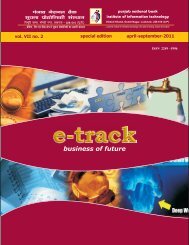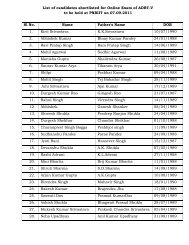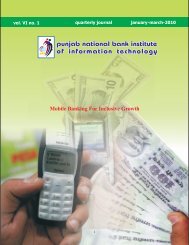Thought for the quarter - Punjab National Bank Institute of ...
Thought for the quarter - Punjab National Bank Institute of ...
Thought for the quarter - Punjab National Bank Institute of ...
You also want an ePaper? Increase the reach of your titles
YUMPU automatically turns print PDFs into web optimized ePapers that Google loves.
e-tracksupported by suitable mining techniques go a longway in alleviating most problems associated withdata-based management decisions. In <strong>the</strong> insuranceindustry, <strong>for</strong> example, it could lead to a wide range <strong>of</strong>benefits like creation <strong>of</strong> better policy types that aimat <strong>the</strong> right segments, better pricing strategies, morereliable risk assessment and underwriting etc; apartfrom higher efficiencies in claims settlement ando<strong>the</strong>r customer service activities. It should howeverbe ensured that <strong>the</strong> data obtained is homogenous innature and at <strong>the</strong> right level <strong>of</strong> granularity. Datawarehousing and mining techniques provide <strong>the</strong>right balance <strong>for</strong> maintenance <strong>of</strong> a high level <strong>of</strong> datarelated accuracy.Insurance: A matter <strong>of</strong> choiceInsurance is defined as <strong>the</strong> equitable transfer <strong>of</strong><strong>the</strong> risk <strong>of</strong> a loss, from one entity to ano<strong>the</strong>r, inexchange <strong>for</strong> payment. An insurer is a companyselling <strong>the</strong> insurance; an insured or policyholder is<strong>the</strong> person or entity buying <strong>the</strong> insurance policy. Theinsurance rate is a factor used to determine <strong>the</strong>amount to be charged <strong>for</strong> a certain amount <strong>of</strong>insurance coverage, called <strong>the</strong> premium. Riskmanagement, <strong>the</strong> practice <strong>of</strong> appraising andcontrolling risk, has evolved as a discrete field <strong>of</strong>study and practice.The transaction involves <strong>the</strong> insured assuminga guaranteed and known relatively small loss in <strong>the</strong><strong>for</strong>m <strong>of</strong> payment to <strong>the</strong> insurer in exchange <strong>for</strong> <strong>the</strong>insurer's promise to compensate (indemnify) <strong>the</strong>insured in <strong>the</strong> case <strong>of</strong> a large, possibly devastatingloss. The insured receives a contract called <strong>the</strong>insurance policy which details <strong>the</strong> conditions andcircumstances under which <strong>the</strong> insured will becompensated.The customer today can choose betweeninsuring and not insuring, between bearing <strong>the</strong> riskhimself or through industry / mutual arrangements,or passing on <strong>the</strong> risk to an insurer. His choicedepends on <strong>the</strong> industry players, schemes available,<strong>the</strong> nature and types <strong>of</strong> risks, <strong>the</strong> costs involved, <strong>the</strong>associated risks, <strong>the</strong> probability <strong>of</strong> occurrence, <strong>the</strong>likely impact on business and <strong>the</strong> risk appetite,approach and attitude. Insurance companies thatrecognize this factor; and are proactive in managingand tuning <strong>the</strong>ir business to customer needs willprove most successful in today's competitiveenvironment.Trends <strong>of</strong> Insurance in IndiaWith <strong>the</strong> de-regulation in Indian Insuranceindustry, <strong>the</strong> monopoly <strong>of</strong> public sector companies inlife insurance and general insurance has come to anend. The insurance industry in India has gonethrough many transitions, <strong>the</strong> latest being <strong>the</strong>opening up <strong>of</strong> <strong>the</strong> insurance sector to private andinternational players. With this, <strong>the</strong> monopoly <strong>of</strong> <strong>the</strong>public sector nationalized insurance companies hasbeen replaced by competition albeit in a spaceregulated by <strong>the</strong> IRDA, <strong>the</strong>reby giving a choice <strong>for</strong><strong>the</strong> first time to <strong>the</strong> consumer, <strong>the</strong> insured. IRDA has<strong>the</strong> responsibility <strong>of</strong> protecting <strong>the</strong> interest <strong>of</strong>insurance policyholders. Towards achieving thisobjective, <strong>the</strong> Authority has taken <strong>the</strong> followingsteps:IRDA has notified Protection <strong>of</strong> PolicyholdersInterest Regulations 2001 to provide <strong>for</strong>:policy proposal documents in easilyunderstandable language; claims procedure inboth life and non-life; setting up <strong>of</strong> grievanceredressal machinery; speedy settlement <strong>of</strong>claims; and policyholders' servicing. TheRegulation also provides <strong>for</strong> payment <strong>of</strong>interest by insurers <strong>for</strong> <strong>the</strong> delay in settlement<strong>of</strong> claim.January-March2011 10










